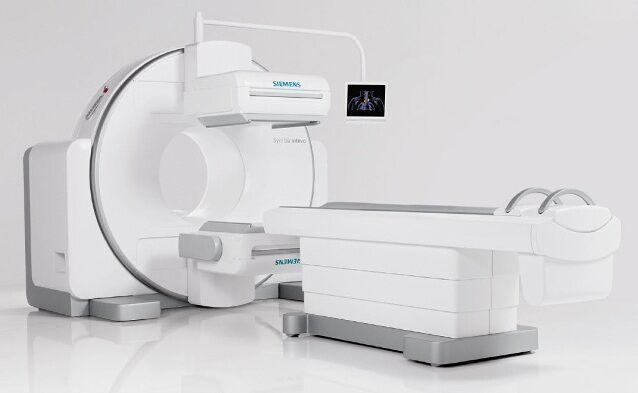Below is a selection of educational and scientific talks from the official SNMMI program that will be taking place at the St. Louis Convention Center.
Saturday, June 7th Rm# 228
Molecular Imaging and Targeted Therapeutics
11:15 am -12:00 pm
Amyloid PET Imaging in Clinical Trials
Michael D. Devous, Sr., PhD
Saturday, June 7th Rm# 223-224
The Journey to PET/MRI: Present State and Future Applications
9:40 am -10:10 am
PET/MRI Quantitative Techniques
Georges N. El Fakhri, PhD
10:10 am -10:20 am Break
10:20 am -10:50 am
PET/MRI Applications in Neurodegenerative Disorders
Alexander E. Drzezga, MD
12:50 pm -1:20 pm
PET/MRI Applications in Imaging Gynecological Malignancies
Farrokh Dehdashti, MD
1:20 pm -1:45 pm
PET/MRI Applications in Imaging in Multiple Myeloma
Lale Kostakoglu, MD, MPH
Saturday, June 7th Rm# 226
Advances in Clinical and Molecular Nuclear Cardiology
10:35 am - 11:10 am
Evaluation of Right Ventricular Function and Its Prognostic Relevance
Daniel S. Berman, MD
11:10 am - 11:45 am
Hybrid SPECT/CT, PET/CT, and PET/MR for CAD Detection
Thomas Hellmut Schindler, MD
12:45 pm - 1:15 pm
Imaging Vascular Inflammation and Atherosclerosis
Mehran M. Sadeghi, MD
1:15 pm - 1:45 pm
NaF for Imaging Coronary Artery and Valvular Calcification
Albert J. Sinusas, MD,FACC, FAHA
Saturday, June 7th Rm# 220-221
Theranostics Nuclear Medicine in Oncology – Updates and Future Directions
1:45 pm - 2:10 pm
Updates on Peptide Receptor Radionuclide Therapy
Richard P. Baum, MD, PhD
Saturday, June 7th Rm# 229
Molecular Imaging for Assessing Response to Therapy
3:00 pm - 4:00 pm
Novel Molecular Imaging Agents for Monitoring Response to Therapy
David A. Mankoff, MD, PhD
Saturday, June 7th Rm# 274
The Most Used PET Radiotracers Beyond F-18 FDG in Korea
4:30 pm - 5:00 pm
The Clinical Value of High-Resolution PET/CT Using F-18 FP-CIT for the Differential Diagnosis of Atypical Parkinsonian Disorders
Jae Seung Kim, MD, PhD
Saturday, June 7th Rm# 267
Pediatric Hybrid Imaging
5:00 pm - 5:30 pm
SPECT/CT in Pediatric Oncology
Helen R. Nadel, MD
Sunday, June 8th Rm# 220-221
PET Imaging of Hypoxia and Radiation Therapy *
1:20 pm - 1:45 pm
Hypoxia PET/CT Clinical Studies and Radiation Therapy
Farrokh Dehdashti, MD
Sunday, June 8th Rm# 220-221
Practical PET
3:15 pm - 3:45 pm
How to Perform, Interpret, and Report PET Myocardial Perfusion Imaging
Parthiban Arumugam, MD
Sunday, June 8th Rm# 267
Imaging Proteinopathies in Neurodegenerative Diseases
2:45 pm - 3:15 pm
Amyloid PET Tracers
Alexander E. Drzezga, MD
Sunday, June 8th Rm# 240
Amyloid and Tau PET Imaging: Current Status
5:00 pm - 5:30 pm
The Centiloid Project
Christopher C. Rowe, MD, FRACP
5:30 pm - 6:00 pm
Advances in Tau PET
Nobuyuki Okamura, MD, PhD
Sunday, June 8th Rm# 267
Differentiating Benign from Malignant Bone Disease: The Role of Multimodality Imaging
4:30 pm - 5:00 pm
Differentiating Benign from Malignant Bone Disease: The Role of PET/CT
Andrei Horia Iagaru, MD, FACNM
5:00 pm - 5:30 pm
Differentiating Benign from Malignant Bone Disease: The Role of SPECT/CT
Stephen C. Scharf, MD
Sunday, June 8th Rm# 222
PET/CT and PET/MR Imaging of Atherosclerosis and Vulnerable Plaque
5:00 pm - 5:30 pm
PET/CT in Clinical Trials of Atherosclerosis
Ahmed Tawakol, MD
Monday, June 9th Rm# 220-221
Quantitative PET for Therapy Planning and Assessment of Response *
12:30 pm - 1:15 pm
Advances and Technical Challenges Toward Quantitatively Harmonized PET Imaging for Cancer Clinical Trials and Clinical Practice
John J. Sunderland, PhD
1:15 pm - 2:00 pm
Clinical Applications of Quantitative Imaging in Planning and Assessing Cancer Therapies
Richard L. Wahl, MD
Monday, June 9th Rm# 222
SPECT/CT and PET/CT Respiratory Gating
1:15 pm - 2:00 pm
Do We Need Respiratory Gating for PET/CT Imaging?
Tinsu Pan, PhD
Monday, June 9th Rm# 241-242
Multimodality Imaging of Neuroendocrine Malignancies and Synergy with Therapy
1:00 pm - 1:30 pm
SPECT/CT and PET/CT with Various Molecular Imaging Agents in Neuroendocrine Tumors
Richard P. Baum, MD, PhD
Monday, June 9th Rm# 222
PET and Multiparametric MRI of Prostate Cancer
4:45 pm - 5:30 pm Multiparametric MRI of Prostate Cancer
Drew A. Torigian, MD, MA
5:30 pm - 6:15 pm Translational and Clinical PET of Prostate Cancer
Hossein Jadvar, MD,PhD,MPH,MBA,FACNM
Tuesday, June 10th Rm# 241-242
Liver-Directed Therapy with Y-90 Microspheres
8:30 am - 9:00 am
The Role of PET/CT in Y-90 Microsphere Quantification and Dosimetry
Vanessa L. Gates, MS
9:00 am - 9:30 am
Radiation Dosimetry and Outcomes in Y-90 Microsphere Therapy
Shyam M. Srinivas, MD, PhD
Tuesday, June 10th Rm# 223-224
Brain Analysis Software in PET/CT and SPECT/CT *
10:00 am - 10:45 am
Diagnostic Statistical Brain Mapping Analysis for Brain PET Analysis in Dementia
Satoshi Minoshima, MD, PhD
Tuesday, June 10th Rm# 274
Advances in PET Myocardial Perfusion Imaging: Radiotracers and Quantification of Blood Flow
10:00 am - 10:15 am Regulation of Myocardial Perfusion and Flow: Role of the Epicardial and Microcirculation
Heinrich R. Schelbert, MD, PhD
10:15 am - 10:30 am
Tracers for Perfusion and Flow – Can Rb82 Do the Job of NH3 and H20, and What About Flurpiridaz?
Jamshid Maddahi, MD
11:00 AM - 11:15 AM Clinical Value of Flow Quantification to Guide Therapy
Viviany R. Taqueti, MD, MPH
Tuesday, June 10th Rm# 223-224
Clinical Dosimetry of I-131 and Y-90 Therapies for Thyroid and Hepatic Malignancies *
12:30 PM - 1:15 PM Yttrium-90 Microsphere Therapy Planning and Dose Calculations
Srinivas Cheenu Kappadath, PhD
Tuesday, June 10th Rm# 223-224
SPECT/CT in Thyroid and Parathyroid Disease
2:45 pm - 3:30 pm
Thyroid Cancer Imaging:The Role of Diagnostic Radioiodine SPECT/CT
Anca M. Avram, MD
Wednesday, June 11th Rm# 240
Potentials of Brain PET/MRI
8:00 AM - 8:30 AM The Technical Revolution of Integrated PET/MRI
Bernd J. Pichler, PhD
8:30 am - 9:00 am
Methodological Challenges and Opportunities in Brain PET/MRI
Ciprian Catana, MD, PhD
9:00 am - 9:30 am
Future Applications for Brain PET/MRI
Osama Sabri, MD, PhD
Wednesday, June 11th Rm# 274
PET/MRI
9:45 am - 10:15 am
Technical Developments in PET/MRI
Craig S. Levin, PhD
10:15 am - 10:45 am
Clinical Aspects of PET/MRI
Alexander R. Guimaraes, MD, PhD




